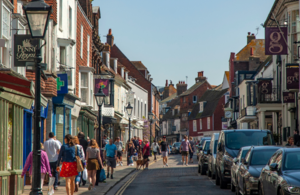Report - Beautiful and Safe High Streets
A blog post on the Office for Place’s latest event, where our panel discussed the role of place quality in creating and stewarding prosperous and safe high streets and town centres, written by advisory board members Nicholas Boys Smith and Caroline Simpson.

On Wednesday 7 June, the Office for Place ran a webinar on “beautiful and safe high streets.” We had great and expert panellists: Caroline Simpson, the chief executive of Stockport Council; Mark Robinson, Chair of the High Street task force; Paul Tebbitt and Annie Keegan who are working on the Mansfield design code; and Scott Adams, an Urban designer at BPTW and formerly of DLUHC and Nicholas Boys Smith who chaired it.
We were asking the question: what’s the best path to prosperous and busy high streets with low levels of antisocial behaviour? Where do you start? What do you need to prioritise? What should you do? What should you not to?
There was actually a startling degree of consistency between what the different panellists, coming from different perspectives in different places said.
Here are a few themes we would pull out. Very much our personal reflections! First of all, on process and governance:
-
The vision thing. You do need a clear vision of a better, busier, more prosperous and lovely place.
-
Ownership from the top. That vision needs to be owned and committed to at the top of the local council and other relevant organisations - both at political and officer level. There is no real substitute for that.
-
Empowering frameworks not rigid masterplans. Be wary of overly rigid masterplans. They can constrain as much as they empower. Better to have a clear framework to de-risk investment and development. Have flexibility within a framework working to the vision, not a tight all constraining exoskeleton. Flex plans to opportunities and be pragmatic.
-
Dare to be emotional. Care about pride, about past, about love of place. That does not preclude looking into the future, but you need to know where you’re coming from and recognise that humans are emotional as well as rational.
-
Perhaps above all, safe places or busy places. Find a thousand different ways to fill your town centre with people. At the heart of this, nearly always, is re-introducing homes to the town centre as was normal until 100 years ago. But also: what events can you run at the weekend? How can you tempt children, older people, visitors into your town centre for fun and work?
-
Success needs many parents and partnerships. No one organisation, and certainly not the council alone, can regenerate a high street or a town centre. It’s not just about de-risking investment via planning certainty. It’s also about partnerships with people, organisations and place. Multiple people and organisations should feel ownership of the change and improvements. Be open to any idea and any suggestion, and be prepared to back some mistakes!
-
Get cracking. Don’t wait for perfection. Start small, if necessary. Build momentum. Be relentless.
-
Whenever possible, do nice things first. When it comes to potentially tricky issues like parking and movement, it’s normally right to make things easier (i.e., easier to walk and cycle safely) before you start constraining other options for getting about. Build confidence with evidence and example that streets filled with people not cars nearly always have busier and more profitable shops.
And moving a bit more to the physical form of the challenge.
-
Town centres not high streets. Don’t just think about high streets, but about wider town centres. The problem and the opportunity is wider than any one street.
-
Re-stich your town centres. Worry about acres of surface car parks and fast, dangerous roads. They drain the life out of the middle.
-
Homes. Homes. Homes. All successful in town centres need people aspiring to and actually living there. Town centres are places to live in, not just to work and shop.
-
Create places people want to be in. When design new places or reviving old ones, worry about this more than about what is appropriate “for today”. Human needs are surprisingly perennial. Place trumps time.
-
Recycle old buildings more normally than pulling them down. Above all when they’re beautiful, popular and contribute to pride of place. This is almost always more sustainable.
-
Do people like it? If everyone is opposed to what you’re doing, you’re probably doing the wrong thing. But there is also a need sometimes to help people see that a better, more humane and more prosperous future is possible.